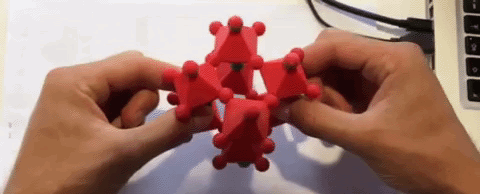Solar cells are traditionally made from high purity semiconductor materials, such as silicon. Their production requires high temperatures and ultra-clean environments, which makes them expensive. The resulting structure of the material is extremely ordered and rigid. A novel class of solar cell materials has recently been discovered. These materials are called hybrid perovskites. They have the same efficiency for converting light into electricity as the traditional semiconductors, but do not rely on the same expensive production process. This favourable combination has attracted many scientists to this material over the past decade.
A hybrid perovskite solar cell can be made simply by coating a chemical solution onto glass. This mild processing procedure is possible because of the unordered and flexible structure of the material. So unlike silicon, which you can think of as a rigid and brittle popsicle, this material behaves more like a jelly. Similar to how a jelly wobbles when you touch it, light makes the atoms inside the hybrid perovskite jiggle when it is absorbed. It remains a remarkable (and unexplained!) fact that this jiggly material works so well as a solar cell.
My research focuses on studying the interaction of light with hybrid perovskites. I want to understand how the unordered and flexible structure of this material defines its properties. In one type of experiments we “poke” the jelly with light and watch how it jiggles. In another type we look how it behaves when we cool and eventually freeze it (making it more like a brittle popsicle). We also put other “ingredients” in our jelly mixtures to see how that changes the properties. By increasing our understanding of the material, we aim to further improve the properties. This will help to make better solar cells in the future.
NanoDTC PhD Student 2016

